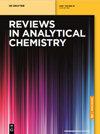随机动态质谱扩散方法及其在分析物三维结构分析中的应用
IF 3.6
3区 化学
Q2 CHEMISTRY, ANALYTICAL
引用次数: 12
摘要
摘要:在功能模型的最新发展中,有一条直接的线将实验质谱变化强度的分析离子的峰与其热力学、动力学和扩散参数联系起来。结果强度的时间行为遵循一定的规律:${{\text{D}}_{{\text{SD}}}}{\text{ }} = {\text{ }}1.3193{\text{ }} \times {\text{ }}{10^{ - 14}}{\text{ }} \times {\text{ }}A{\text{ }} \times {\text{ }}{{(\overline {{I^2}} - {{(\bar I)}^2})} \over {{{(I - \bar I)}^2}}}.$ DSD = 1.3193 × 10−14 × a × (I2¯−(I¯)2)(I−I¯)2。这个公式是普遍适用的,经验上是可以检验和验证的。它将强度与所谓的随机动态扩散“DSD”参数联系起来。到目前为止,它在小规模研究中的应用,使用软电离电喷雾、大气压化学电离、基质辅助激光解吸/电离或碰撞诱导解离方法,已经表明DSD参数与所谓的量子化学扩散参数“DQC”线性相关,该参数是在Arrhenius理论中得到的。因此,DSD参数将离子的实验可测量参数与其三维(3D)分子和电子结构联系起来。到目前为止,确凿的经验证据令人信服地表明,质谱法似乎不仅是一种高度准确、精确和选择性定量的强大仪器,而且当它与高精度的计算量子化学方法相辅相成时,还能够提供被分析物的确切3D分子结构。本文章由计算机程序翻译,如有差异,请以英文原文为准。
A stochastic dynamic mass spectrometric diffusion method and its application to 3D structural analysis of the analytes
Abstract There is a straightforward line in the recent development of the functional model connecting the experimental mass spectrometric variable intensity of a peak of an analyte ion with its thermodynamic, kinetic and diffusion parameters. It has been shown that the temporal behavior of the outcome intensity obeys a certain law: ${{\text{D}}_{{\text{SD}}}}{\text{ }} = {\text{ }}1.3193{\text{ }} \times {\text{ }}{10^{ - 14}}{\text{ }} \times {\text{ }}A{\text{ }} \times {\text{ }}{{(\overline {{I^2}} - {{(\bar I)}^2})} \over {{{(I - \bar I)}^2}}}.$DSD = 1.3193 × 10−14 × A × (I2¯−(I¯)2)(I−I¯)2. This formula is universally applicable and empirically testable and verifiable. It connects the intensity with the so-called stochastic dynamic diffusion “DSD” parameter. Its application to small-scale research, so far, using soft-ionization electrospray, atmospheric pressure chemical ionization, matrix-assisted laser desorption/ionization or collision-induced dissociation methods has shown that the DSD parameter is linearly connected with the so-called quantum chemical diffusion parameter “DQC,” obtained within Arrhenius’s theory. Therefore, the DSD parameter connects experimental measurable parameters of ions with their three-dimensional (3D) molecular and electronic structures. The corroborated empirical proof, so far, has convincingly argued that the mass spectrometry appears to be not only a robust instrumentation for highly accurate, precise and selective quantification but also is capable of providing the exact 3D molecular structure of the analytes, when it is used complementary to high accuracy methods of the computational quantum chemistry.
求助全文
通过发布文献求助,成功后即可免费获取论文全文。
去求助
来源期刊

Reviews in Analytical Chemistry
化学-分析化学
CiteScore
7.50
自引率
0.00%
发文量
15
审稿时长
>12 weeks
期刊介绍:
Reviews in Analytical Chemistry publishes authoritative reviews by leading experts in the dynamic field of chemical analysis. The subjects can encompass all branches of modern analytical chemistry such as spectroscopy, chromatography, mass spectrometry, electrochemistry and trace analysis and their applications to areas such as environmental control, pharmaceutical industry, automation and other relevant areas. Review articles bring the expert up to date in a concise manner and provide researchers an overview of new techniques and methods.
 求助内容:
求助内容: 应助结果提醒方式:
应助结果提醒方式:


